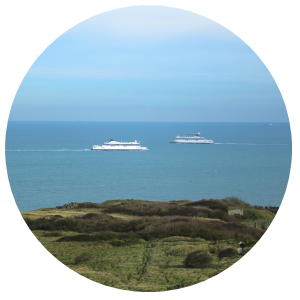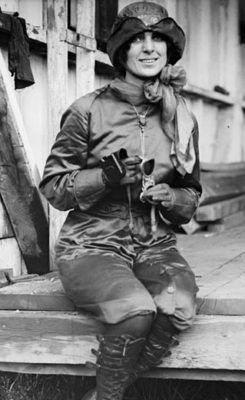Crossing the Channel: in ways you might not expect
 La Manche is what the French call the strip of sea that lies between England and France. Anglo Saxons know it as the English Channel. But what else?
La Manche is what the French call the strip of sea that lies between England and France. Anglo Saxons know it as the English Channel. But what else?
At its narrowest point it’s only twenty-one miles wide. But over the centuries it has been both a barrier against the invasion of Blighty and a two-way highway for trade and immigration. The shortest distance is between Dover and Calais, and, on a clear day, the opposite side can be easily seen from either shore.
Since 1994 it’s been possible to cross under La Manche via the Chunnel. One hundred and forty years before the Channel Tunnel was opened, Queen Victoria praised an early proposal for an undersea crossing, “in the name of all the ladies in England.”
The crossing can be very disagreeable in bad weather and she felt that women especially would appreciate what remains the tunnel’s top selling point today. The gratifying lack of motion in the rail passage through the seabed rocks is routinely emphasised.
Crossing the Channel: a history of attempts
Naturally there are many ways to cross the Channel.
Historically, Julius Caesar showed the Romans how to do it in galleys in 55 BC.
So did William the Conquerer, who landed an entire army in England prior to the Battle of Hastings in 1066. And the Bayeux Tapestry, a medieval equivalent of today’s comic strip, records what happened in a sixty-eight metre long succession of embroidered “sketches”.
In 1588, The King of Spain tried it, but, as every school kid knows, he had his beard singed by Francis Drake.
Napoleon thought about it too but never got around to trying. News of his defeat, however, arrived in London via pigeons that flew over the Channel from Waterloo to London.
Hitler was determined to invade the UK during WWII. However, his invasion plan, Operation Sea Lion, never got going after the Luftwaffe lost the Battle of Britain.
Then, in 1944, the biggest, most complicated and ambitious effort by far was the successful Allied invasion of Normandy.
Before the Channel Tunnel: flying over
 Crossing the Channel in the air started in 1785 when Frenchman Jean-Pierre Blanchard and American John Jeffries floated over the sea in a gas balloon.
Crossing the Channel in the air started in 1785 when Frenchman Jean-Pierre Blanchard and American John Jeffries floated over the sea in a gas balloon.
In 1909 Louis Blériot flew the first heavier-than-air contraption from Calais to Dover. This was followed a year later by the first flight with passengers, and the pilot’s cat, according to the manifest.
Harriet Quimby was the first woman to be granted a pilot’s licence in America. She then went on to become the first woman to fly the Channel. She did it in 59 minutes in 1912.
Crossing the Channel…without transport
These days, the most popular method for passengers and cars is by ferry or under the sea via the Chunnel. The trip to France can be as short as an hour and a half from Dover.

If the idea appeals to you, here are some things to think about:
- Firstly, you’ll have to save up and book ahead. It’s compulsory to contact the Channel Swimmers Association at least two years in advance to secure a slot to for your attempt at the crossing. Practice swimming in cold water. Expect temperatures of 14 to 18 degrees centigrade, although these can plummet to 6 degrees. The point is that you must complete a six-hour swim in similar temperatures before the CSA will let you attempt a crossing.
- Then you’ll need 2,750 Pounds to pay for the compulsory escort boat and registered pilot.
So, bearing in mind that a budget airline flight from London to France can cost under ten quid, if you’re still interested in swimming, here are some further tips.
- You are only permitted to use goggles, one cap, a nose clip, ear plugs and a legless, sleeveless costume.
- Try smothering yourself in various forms of grease to protect against the cold—goose fat is the most popular.
- Get used to eating in water. During the swim, food must be passed to you by a long pole from your escort boat.
And don’t forget that the Channel is one of the busiest shipping lanes in the world. 600 tankers and 200 ferries make the crossing every day.
Not really your problem though, because it’s your escort pilot’s job is to make sure you don’t get mowed down.
Cross the Channel…now!
Finally, if you’re still thinking about giving it a go, the sooner the better.
The way the Brexit negotiations are going, it seems that whatever the outcome, the distance between the European Union and the United Kingdom is an ever-widening gap.
How many ways have you crossed the Channel? Are you thinking of making the journey soon? We’d love to hear your thoughts and reflections in the comments section below!
Image credits
1. Ships cruise the English Channel, by Alyona Rudenko via Shutterstock
2. Bayeux Tapestry, by Myrabella via Wikipedia
3. Harriet Quimby, via Wikipedia
4. The port of Dover, by Captain Haddock via Wikipedia
5. Swimmer in the English Channel, by skeeze via Wikipedia









In addition to Ray’s (excellent) channel crossing information, the 1785 balloon flight has some interesting American backstories involving ‘the’ Benjamin Franklin no less.
“Dr Jeffries” the mentioned co-flyer was a Boston born associate of William Franklin, Ben Franklin’s estranged loyalist (aka pro-British) son.
The good Dr Jeffries and French co-pilot (Jean-Pierre Blanchard) had a very exciting trip. It was reported (at Benjamin Frankin’s Passy dinner table) that “with Calais insight, the balloon plunged four thousand feet in a matter of minutes and the fliers scurried to jettison overboard anything/everything. First went the damask curtains and garlands (curtains?) followed by the brandy (!) books (damn) and other provisions. Then the men’s clothing went and still, they only just made landfall.”
Actually, my reporter says they landed into a Calais tree and it took another 30 minutes to extract them “in their shirtsleeves”. Truly intrepid people.
Bonjour Bob,
Thanks for your comments and apologies for the tardy reply – I’m on a walking holiday in Spain and connections are not always that good.
Anyway, as a person who has flown quite a bit, but always clutching the armrests with white knuckles, just reading the details of the flight Jeffries and Blanchard made, makes my blood run cold. And the worst part was definitely chucking out the Armagnac (or Cognac, probably in those days).
Thanks again for reading my article.
Amciclement
Ray